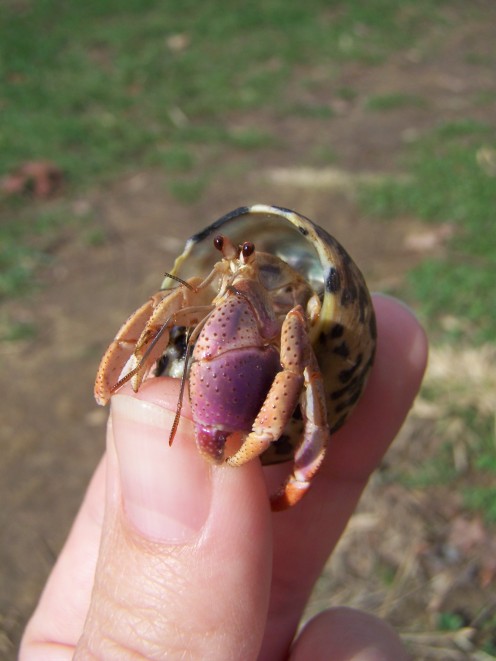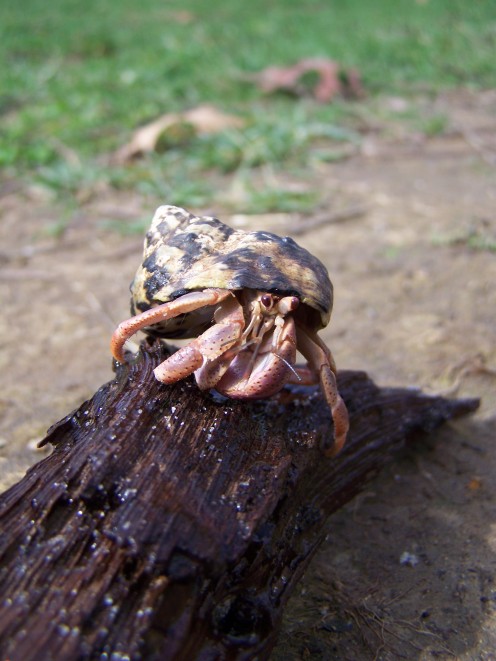- HubPages»
- Education and Science»
- Life Sciences»
- Marine Biology»
- Marine Life
Hermit Crab Care: Building a Natural Crabitat

Care for your hermit crabs naturally. Provide them with living soil and plenty of fresh, clean water. Your hermit crabs also require a dish of marine saltwater to keep them from dying. Feed your crabs a variety of natural foods and avoid those prepackaged garbage foods. A small amount of calcium is required for proper growth as well. Try baking eggshells in the oven and crushing them into a fine powder. Serve this on food or in a separate dish.
© Copyright Notice ©
My photographs are mine, taken by me, with my camera. You may use them for personal reasons (desktop backgrounds, personal websites or you can print them for personal use.)
If you choose to use them on websites I require a link back to my HubPages. You may link to my profile or to one of my Hubs.
You may not use them without my permission or for profit.
I sell my art and if you are interested in purchasing it send me a message.
ALL of my articles are MINE and you may NOT use them for anything but reading on my page.

Substrate: My substrate is sandy compost. A crabitats’ substrate should have enough mass and moisture so the crabs can burrow into without the soil collapsing. There are several substrates to choose from like coconut coir, peat moss and even pure sand. I prefer to make a loamy soil because in the event it should collapse, my crabs can easily escape a crushing death. Loamy soil also supports a variety of beneficial organisms.
Supplies List:
- Sand
- Compost
- A bit of clay
- Broken down leaves
- Pine straw*
- Red wigglers
- Small stones
- Heater
- Water pump
- Humidity gage
- Thermometer
Sand: I use plain, clean sand. There is nothing special about it other than it contains no toxic substances. Use play sand and save yourself a bundle compared to “pet quality” pre-packaged substrates.
Organic compost: Using organic compost will feed not only your red wigglers and pillbugs, it will feed your crabs as well.
Clay: The clay gives staying power to your crabs' tunnels. It probably contains nutrients as well. I use clean yard clay from my organic yard.
Stones: I use smooth river stones throughout the substrate to keep it from packing down. The crabs enjoy moving the stones around as well.
Leaves: I use a combination of pine, oak, poplar, and whatever else I have that isn’t toxic to my crabs.
Pine Straw: I have used organic pine straw forever with my crab. He not only loves to burrow in it, he eats it as well. Fresh pine needles contain vitamin C and other nutrients. Pine straw is wonderful as a bedding and has a fresh, clean scent. *Some people claim pine straw will kill your crabs. I have never seen a problem with them living in it and eating it. Use it at your own risk.
Red wigglers: The keep the soil aerated, feed your crabs and keep food from building up. I added a small handful to my crabitat. As long as they have plenty of food and good soil, red wigglers multiply like mad. Crabs should enjoy eating the eggs and worms.
Pill bugs: They work the same as red wigglers and really love to clean up leftover food. Pill bugs have family units and usually stay within a short distance of their birth-den. Keep your pill bugs happy by providing rotting logs and stones that your crabs cannot move about. These are amazing creatures that play an important role in your crabitat.
Mixing the Substrate:
Simply mix your soils together to form an airy mass. It should hold together when compressed but break apart with a little fiddling. Add clean water to the soil so that it feels like a well wrung out sponge.
Add the soil to the crabitat and then pack it down lightly. Add the red wiggler worms to the surface. They will burrow down on their own.
Arrange the logs and stones and other decorations. Make sure they are securely placed so they cannot get knocked over. I like to bury mine partially in the soil. Remember, add items your crabs cannot move around so the pill bugs will have a safe homestead.
Add the pill bugs.
Before adding the crabs, finish connecting and setting up your hardware such as, water pumps, filters and heating structures. Add your crabs once you’re sure the system is up and running smoothly.
Pop the top onto your crabitat and watch your little guys enjoy their new life!






